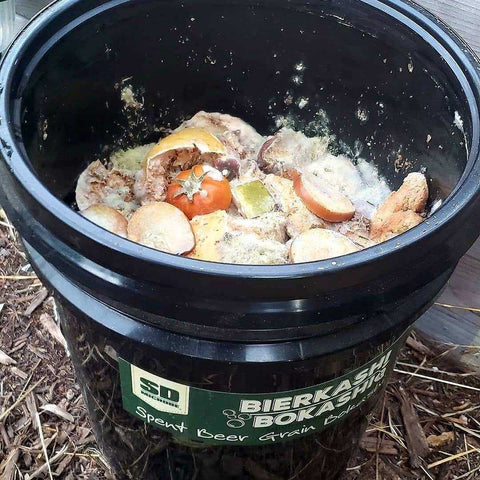
How to Add Organic Matter to your Soil with Bokashi Food Scraps: Digging a Trench
Share
One way you can add organic matter to your native soil is by adding the broken down food scraps left over from your bokashi composting bucket. In this post, we’ll show you how to add organic matter to your soil in 6 easy steps.
What is soil organic matter?
Soil organic matter is the organic component of soil, consisting of three primary parts including small (fresh) plant residues and small living soil organisms, decomposing (active) organic matter, and stable organic matter (humus). Soil organic matter serves as a reservoir of nutrients for crops, provides soil aggregation, increases nutrient exchange, retains moisture, reduces compaction, reduces surface crusting, and increases water infiltration into soil.
What is organic matter’s function in soil?
Four functions of organic matter in soil are nutrient supply, increasing water-holding capacity, soil aggregation, and erosion prevention.
Nutrient supply
Upon decomposition, nutrients are released in a plant-available form.
Water-holding capacity
Organic matter behaves somewhat like a sponge. It has the ability to absorb and hold up to 90 percent of its weight in water. Another great advantage of organic matter is that it releases nearly all of the water it holds for use by plants. In contrast, clay holds great quantities of water, but much of it is unavailable to plants.
Soil aggregation
Organic matter improves soil aggregation, which improves soil structure. With better soil structure, water infiltration through the soil improves, which improves soil’s ability to take up and hold water.
Erosion prevention
Because of increased water infiltration and stable soil aggregates erosion is reduced with increased organic matter.
Benefits of adding bokashi food scraps to your soil:
- Food waste in landfills generates methane, a potent greenhouse gas. When food waste is diverted from the landfill, methane emissions are significantly reduced.
- Reduce or eliminate the need for chemical fertilizers.
- Promote a higher yield of what you’re growing.
- Enhance water retention.
Adding bokashi food scraps to your soil.
Once your bokashi composting process is complete, you can dig a trench and empty out the contents of your bokashi bucket into it. This is a simple and effective way to add organic matter to your native soil. Unless you’re dealing with a depleted soil like desert soil, after the food scraps have broken down into the soil where you’ve dug your trench, you’ll be able to plant directly into it.
What you’ll need:
- Sealed 5 gallon bucket of bokashi food scraps
- Shovel
-
Find a spot to dig a trench.
The first step is to figure out where you want to dig the trench for your bokashi food scraps. You’ll be able to plant directly into it 2 weeks after adding the food scraps to the soil, so pick a place that is ideal for growing.

-
Use your shovel to dig a trench.
Take your shovel and dig out a trench deep enough that it will allow you to put 2 to 3 inches of soil on top of the food scraps. Make sure to keep loose dirt close to the trench so you can easily shove it back over the trench.

-
Unscrew the gamma seal lid off of your 5 gal bucket.
After you’ve dug out your trench, unscrew the gamma seal lid off of your 5 gallon bucket. At this point, you want to make sure that you see plenty of white fuzz in your food scraps bucket so you know they’re ready to be dumped into the soil.

-
Spread your bokashi food scraps evenly into the trench.
When you’ve made sure that your food scraps are ready to go into the soil, spread them out evenly into the trench.

-
Cover the trench with the loose soil.
Now that your food scraps are in the trench, use your shovel to cover up the trench with the loose soil you dug out.

-
Screw the gamma seal lid back on your bucket.
Once your trench is completely covered you’re going to want to screw the gamma seal lid back onto your bucket.
How quickly will the bokashi food scraps break down once in the soil?
How fast the bokashi food scraps break down in your soil depends a lot on your climate and soil texture. Inherent factors affecting soil organic matter such as climate and soil texture cannot be changed. Climatic conditions, such as rainfall, temperature, moisture, and soil aeration (oxygen levels) affect the rate of organic matter decomposition. Organic matter decomposes faster in climates that are warm and humid and slower in cool, dry climates. Organic matter also decomposes faster when soil is well aerated (higher oxygen levels) and much slower on saturated wet soils.
How long until planting into the soil?
You can plant a cover crop on top of the soil immediately after you’re done covering the trench, but you’ll want to wait at least 2 weeks to plant any high value crops so that the pH in the soil has time to rise.